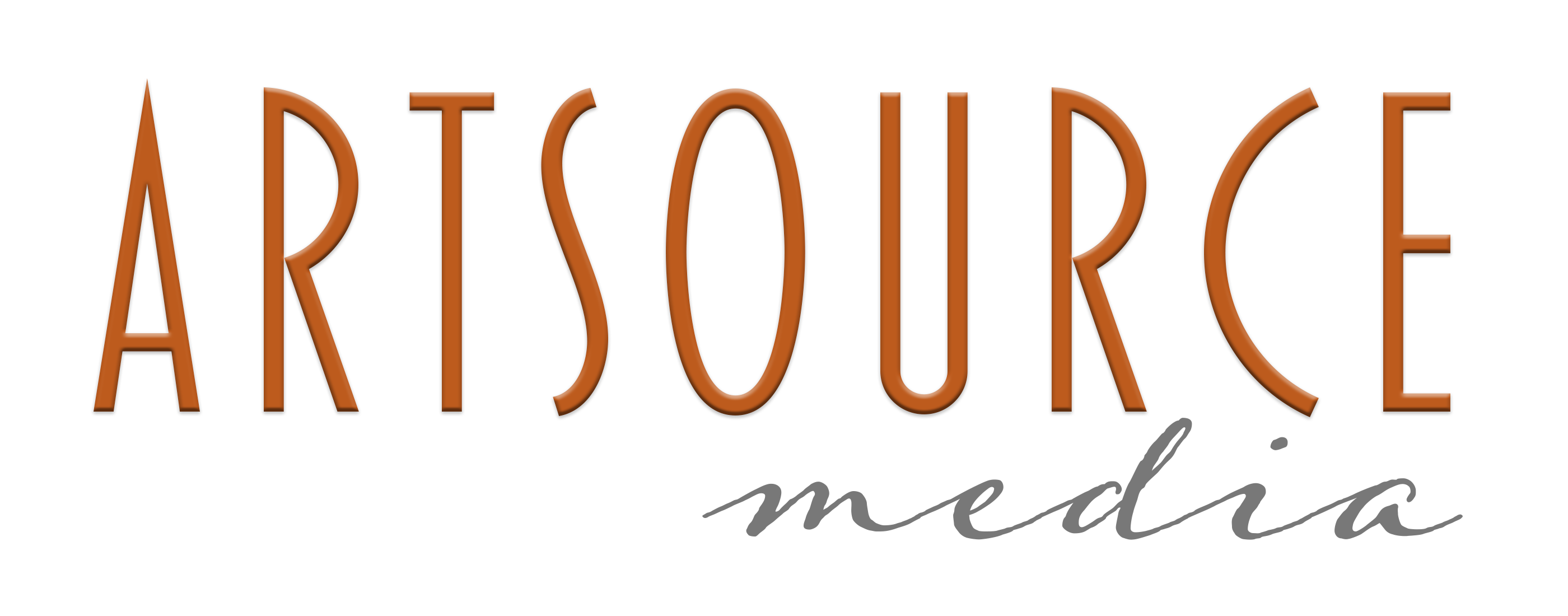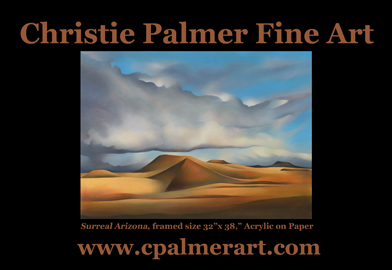With the subtleties of airbrush and the nuances of watercolor, artist Christie Palmer plays with the edges of paint and reality. Her brilliantly hued landscapes, inherently recognizable as some longed-for horizon, capture the ever-changing elements of place and time. We visited the studio of Christie Palmer, overlooking Sedona’s distant red rock vistas where she shared insight into the inspiration and motivation for her original water media work.
Sedona ARTSource: Your original acrylic works look as if you airbrushed them in fine layers onto the surface!
Christie Palmer: Yes, I’ve heard that before from people familiar with airbrush. I’d never really seen an airbrush until a few years ago when someone was demonstrating one at the Watercolor Society meeting. You have to clean the brush all the time and I knew that I would not have the patience to do that. But then, I have the patience to keep layering colors and smoothing things out and somebody else might not have the patience to do that.
So, you develop the piece through blending many layers?
Yes, it adds the subtlety to the painting.
People know you for integrating landscape and abstraction in your work, which comes across as both dramatic and yet serene. One can’t help but notice your atypical use of acrylic paints on watercolor paper.
Yes, I’ve done different things for certain shows. I do like working on the gesso board in all different thicknesses as well.
Where is your work offered in Sedona?
I’m in the Sedona Arts Center. I’ve also been in other galleries. I’ve been involved with Sedona Visual Artists’ Coalition and I was just in their show. And I was in the 39th Annual Juried Member Exhibition at the Sedona Art Center this year.
What would you most like to say about your work and what inspires you?
I think it comes from a deep relationship with nature and the varied elements of weather I see in the landscapes. I’m more drawn to a vast landscape than to a very complicated landscape or subject matter. Maybe because I think nature is just so powerful in how it speaks to us, and it speaks to me through the landscape.
Much of your work also has an architectural feel to it. What inspires those works?
I’m intrigued by certain elements of architecture that I sometimes use in my paintings. I will notice the way that something happens to outline the landscape. Part of a building, or part of an umbrella, for example, might just kind of frame what I’m looking at in the distance. Also, I just want to get people to look at the colors. You know, at first glance a scene might look mundane, but the longer you look the more you see.
I had a fellow artist who asked me, “Do you really see these colors out there that you use in the landscape?” I told him I really do. If you look long enough, you see there’s a little more of this color and a little more of that color. So, I like to help people to see things differently than it looks in the way the camera might pick it up and generate more of the feeling that I experienced when I was there.
Are you working en plein air part of the time?
I don’t work outside a lot because I’m sensitive to different outdoor elements. I never really liked working outside when I was a student in college although as a kid I did do a lot of sketching outdoors. When I am concentrating on coming up with a finished piece of artwork, I’ll start outside but I’ll finish it in the studio.
I often find that I’ll see something from inside the car and I do not have the opportunity to stop. If we are driving by, I will take the picture fast and do the sketch at a later time and finish the work. It’s an interpretation, so it’s not just trying to get a picture.
And, something like this doesn’t come from sitting out there and drawing it. You are saying so much more than any photo could say with what you are doing with the depth and the color and everything.
Tell us about your history as an artist.
I come from a family where my parents were art collectors and my mother was an artist.
She was more commercially oriented, painting Toleware, decorative furniture, wedding invitations, etc. She also drew maps for the phone company during World War II.
So, I always had the tools around the house for any kind of artwork that I wanted whether it was painting or drawing or whatever. I remember starting in an art class about the age of four at our local art center, Evanston Art Center in Illinois. Also, we would go to the studios of various artists that my parents were collecting and look for something new. It was nice exposure to art. When I was looking for a college, I spoke to a Maine artist with whom we were friends who was on the faculty at the University of New Hampshire. He thought I would do well at the university so I applied there and was accepted. I was able to study with him and several other fine gentlemen who are wonderful artists. I received my BA degree in the Arts there.
Have you always worked with water media?
My interest in using water media came from my work at the college. It became apparent that oil paint was not my thing; it wouldn’t do what I wanted it to do. When I started taking water media classes, I just fell in love with it. I think initially there was just one class in water media. I pursued that on independent studies with my professor of water media so I had more opportunity to work in that than I would have had normally.
How would you describe your color palette?
It goes from really warm to cool. It just depends on the subject matter.
How have your tools or techniques changed over the years?
Watercolor paint is different now. Pigments have developed scientifically and are more permanent than they used to be. I started seeing paintings I had done in watercolor that were hanging on the wall and just fading away into nothing. So I began working with the acrylic, handling it more like watercolor and found the intensity of color and the edges and the things that I could do with it seemed to suit me better. That’s kind of the direction I took my studies.
How long have you been in Sedona and how has that a ected your work?
My husband, Tom and I were living in the desert in La Quinta, California previously.
We used to come here for about 15 years before we decided that we’d like to retire here. I think moving to the Southwest de nitely had a big in uence on my use of color. Being in Sedona, it’s nice to be around other artists to see what they are creating even if it’s not something that would be of interest for you. It’s stimulation for your senses and your work and rewarding to get feedback at First Friday events or shows at the Arts Center by talking to someone who’s looking at the work.
Do you also o er giclée prints, or just originals?
No, just originals. I did some note cards for the Open Studios crowd. But I would prefer to just sell the original art.
Do you ever find it difficult to part with a finished work?
It is hard to part with it, but a lot of the times you get to meet the person who’s purchasing the art and that is very rewarding. You find out where it’s going, and it’s fun to get to know the people that will have your artwork.
Is there anything else that you’d like to share with Sedona ARTSource readers?
Maybe just one thing that I read today in my Georgia O’Keefe biography book, her words about how form and shape and color are more important than the subject matter. She said, “The subject matter of a painting should never obscure its form and color, which are its real thematic contents.” That kind of expresses how I feel about my work; that a painting says more than I can say with words. I’m not much of a talker so my paintings are kind of my conversation with the people that see them, my connection. It’s rewarding when I feel a painting speaks to someone — that they connect to a painting in much the same way that I connected with its inspiration.
Thank you, Christie Palmer.
Christie Palmer Art: The Longer You Look The More You See
Interviewed by Lynn Alison Trombetta





